![]()
![]()
![]()
Use LEFT and RIGHT arrow keys to navigate between flashcards;
Use UP and DOWN arrow keys to flip the card;
H to show hint;
A reads text to speech;
10 Cards in this Set
- Front
- Back
|
Mummy bundle |
In order to protect the [prestigious] dead, the Paracas wound the fetal-position body like a giant bobbin with garments and wrapping cloths, and secured offerings deep inside. A lot of symbolism and iconography went into this practice including the textiles and objects surrounding the body - They could tell you much about the individual's status in life. |
|
|
Linear Style textile (know style and technique) |
"Horror Vacui" = repeated images nested inside each other (much like the mummy bundles) inextricable relationship between the embroidery and the woven textile underneath, like a grid oldest style, no overlapping, no solid color areas, the figure/ground distinction is minimized, the background was stitched 1st using a formula, and then the image was embroidered, usually located on the outside of the mummy bundles (possibly an outer protective shell?), related to non-perceptual knowledge, supernaturals, and symbolic. |
|
|
Block Color textile (know style and technique) |
Much more use of negative space - the embroidery covered the textile underneath almost completely; the idea of what's "hidden" Recurring motifs of very physical human figures defying the laws of gravity Images are more organic and naturalistic than Linear, detailed images, composite images (human body & human/animal body), clear demarcation of figure and ground, more imagination and variation in the imagery, more colors than Linear, images are drawn from the known world. |
|
|
Discontinuous Warp and Weft (style and technique) |
The most difficult weaving technique (very few found) not embroidered, the images are woven into the textile, chaotic arrangements, front and back are identical, the figures are shown with a lot of appendages flowing outward in varying directions, varying colors. these textiles were worn as capes so that you would be able to see the entire image when it was worn |
|
|
Key Work: Diagrams and photo of partially unwrapped mummy bundle (pg. 60) 600 BCE - 175 CE |
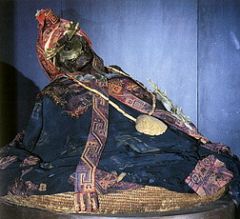
|
|
|
Key Work: Paracas linear style embroidery (pg. 65) 600 BCE - 175 CE |
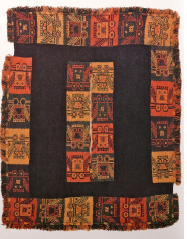
|
|
|
Key Work: Paracas Block Color style mantel with bird “impersonator” image (pg. 68) 600 BCE - 175 CE |
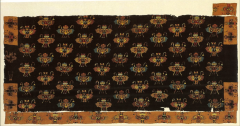
t |
|
|
Key Work: Paracas Block Color style mantel with flying figure motif (pg. 71) 600 BCE - 175 CE |
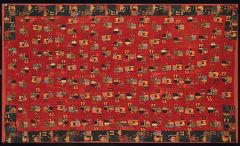
|
|
|
Key Work: Discontinuous Warp and weft wall hanging (see PP for color image) 600 BCE - 175 CE |
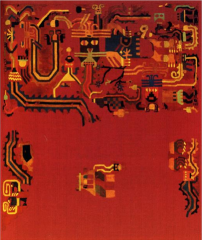
|
|
|
Key Work: Detail of mantle (see PP for image) 600 BCE - 175 CE |

|

